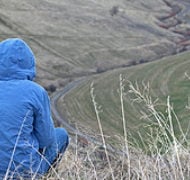From Where I Sit...
Blog / Produced by The High Calling
"You see from where you sit." When I first heard this expression, I thought my professor was being unnecessarily obvious. Turns out I had simply missed the metaphor. I finally got it, but it took learning from increasingly diverse sources for me to appreciate its implications.
Consider the expression as it applies to ways I've learned about Chapter 8 of Matthew's Gospel.
When this miracle-filled follow-up to the Sermon on the Mount was taught by a white Pentecostal perspective (my upbringing), I heard about how to claim the power of Jesus to heal and be healed. From my evangelistic friends, I heard about why I should believe the Good News and put my faith in the Messiah. From Roger, who lives in the city and pastors a largely black urban church, I heard about Jesus as a cultural up-ender and reconciler of broken things. Three perspectives, three interpretations, all coming from where each of the tellers and teachers sat.
Let's focus on the third perspective.
Roger’s specialty is cross-cultural ministry. When he tells me about Matthew 8, it goes something like this:
- First Jesus healed a leper, a member of those walled from the city.
- Second, he healed a Centurion, of the gentile population walled from religion.
- Third, he healed a Jewish woman, an inferior class of people walled from the Temple.
Three miracles done for members of concentric outcast circles, each circle closer to the heart of the Jewish crowd following Jesus down the mountain.
We take for granted that “he himself is our peace, who has made the two [in this case, three] one and has destroyed the barrier, the dividing wall of hostility” (Ephesians 2:14). The crowd, however, would have wondered what on earth Jesus was doing.
From this cross-cultural vantage point, Matthew’s gospel suddenly comes alive to me. These first three recorded miracles follow immediately on the heels of expansive admonitions to love our neighbors. Words on neighbor subjects like murder, adultery, divorce, oaths, revenge, and alms describe a new way for the people to become the Kingdom of God. Then Jesus goes marching down the mountain demonstrating exactly what he means.
Why does Matthew include all of this and then save himself – a male Jew (part of an even smaller circle, though of a bad sort as a tax collector) – for Chapter 9, along with his first specific mention of Pharisees who are closer to the center still? It seems a humble way to introduce yourself: late, in third person and labeled as a “sinner” by others in your similarly privileged cultural circle of Jewish males. I think he does it because Matthew is like the tax man in Luke 18 (maybe it is him) who beats his breast in confession. He knows his sickness and why he needs a doctor.
I can’t read Matthew’s mind or the Spirit’s intentions, but Chapters 4:23 – 9:13 feel like a testimony to me. Sure there are profound sermon lessons and miraculous wonders to strengthen our faith, but I hear Matthew telling his conversion story between the lines.
Like most Jews, Matthew would have been familiar with what the Chosen One was supposed to do. Even if he didn’t spend his youth in the Temple, he would have heard the complaints of the people as he collected money for Rome. Collection was a reminder, after all, that they weren’t in the Promised Land. “You’re a sinner, Matthew! Robbing from God’s people to support our oppressors.... You just wait till He comes.”
Yet it’s this cultural misunderstanding that makes Matthew’s story notable. He tells about a different kind of Messiah than perhaps he once imagined, and he writes the story because it’s his story. He himself has been chosen, picked from behind one of the concentric walls of rejection!
Jesus "came and preached peace to you who were far away and peace to those who were near” (Ephesians 2:17).
I think I'm fairly clear on the basics about Jesus' mission and call, but what if Roger's cross-cultural viewpoint is acceptable and I'm just learning it now at 37? Kinda curbs my self-confidence. And it makes me wonder how my perspective would change if I could sit where Matthew sat, only in today's culture.
Image by Simply Darlene. Used with permission via Flickr. Post written by Sam Van Eman.





